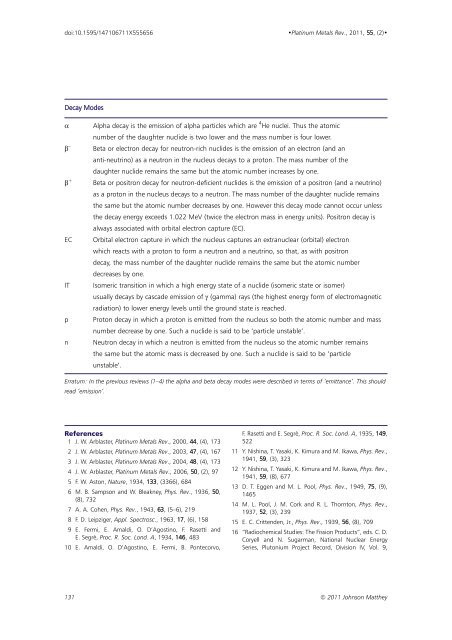Download - Platinum Metals Review
Download - Platinum Metals Review
Download - Platinum Metals Review
Create successful ePaper yourself
Turn your PDF publications into a flip-book with our unique Google optimized e-Paper software.
doi:10.1595/147106711X555656<br />
•<strong>Platinum</strong> <strong>Metals</strong> Rev., 2011, 55, (2)•<br />
Decay Modes<br />
α<br />
β –<br />
β +<br />
EC<br />
IT<br />
p<br />
n<br />
Alpha decay is the emission of alpha particles which are 4 He nuclei. Thus the atomic<br />
number of the daughter nuclide is two lower and the mass number is four lower.<br />
Beta or electron decay for neutron-rich nuclides is the emission of an electron (and an<br />
anti-neutrino) as a neutron in the nucleus decays to a proton. The mass number of the<br />
daughter nuclide remains the same but the atomic number increases by one.<br />
Beta or positron decay for neutron-deficient nuclides is the emission of a positron (and a neutrino)<br />
as a proton in the nucleus decays to a neutron. The mass number of the daughter nuclide remains<br />
the same but the atomic number decreases by one. However this decay mode cannot occur unless<br />
the decay energy exceeds 1.022 MeV (twice the electron mass in energy units). Positron decay is<br />
always associated with orbital electron capture (EC).<br />
Orbital electron capture in which the nucleus captures an extranuclear (orbital) electron<br />
which reacts with a proton to form a neutron and a neutrino, so that, as with positron<br />
decay, the mass number of the daughter nuclide remains the same but the atomic number<br />
decreases by one.<br />
Isomeric transition in which a high energy state of a nuclide (isomeric state or isomer)<br />
usually decays by cascade emission of γ (gamma) rays (the highest energy form of electromagnetic<br />
radiation) to lower energy levels until the ground state is reached.<br />
Proton decay in which a proton is emitted from the nucleus so both the atomic number and mass<br />
number decrease by one. Such a nuclide is said to be ‘particle unstable’.<br />
Neutron decay in which a neutron is emitted from the nucleus so the atomic number remains<br />
the same but the atomic mass is decreased by one. Such a nuclide is said to be ‘particle<br />
unstable’.<br />
Erratum: In the previous reviews (1–4) the alpha and beta decay modes were described in terms of ‘emittance’. This should<br />
read ‘emission’.<br />
References<br />
1 J. W. Arblaster, <strong>Platinum</strong> <strong>Metals</strong> Rev., 2000, 44, (4), 173<br />
2 J. W. Arblaster, <strong>Platinum</strong> <strong>Metals</strong> Rev., 2003, 47, (4), 167<br />
3 J. W. Arblaster, <strong>Platinum</strong> <strong>Metals</strong> Rev., 2004, 48, (4), 173<br />
4 J. W. Arblaster, <strong>Platinum</strong> <strong>Metals</strong> Rev., 2006, 50, (2), 97<br />
5 F. W. Aston, Nature, 1934, 133, (3366), 684<br />
6 M. B. Sampson and W. Bleakney, Phys. Rev., 1936, 50,<br />
(8), 732<br />
7 A. A. Cohen, Phys. Rev., 1943, 63, (5–6), 219<br />
8 F. D. Leipziger, Appl. Spectrosc., 1963, 17, (6), 158<br />
9 E. Fermi, E. Amaldi, O. D’Agostino, F. Rasetti and<br />
E. Segrè, Proc. R. Soc. Lond. A, 1934, 146, 483<br />
10 E. Amaldi, O. D’Agostino, E. Fermi, B. Pontecorvo,<br />
F. Rasetti and E. Segrè, Proc. R. Soc. Lond. A, 1935, 149,<br />
522<br />
11 Y. Nishina, T. Yasaki, K. Kimura and M. Ikawa, Phys. Rev.,<br />
1941, 59, (3), 323<br />
12 Y. Nishina, T. Yasaki, K. Kimura and M. Ikawa, Phys. Rev.,<br />
1941, 59, (8), 677<br />
13 D. T. Eggen and M. L. Pool, Phys. Rev., 1949, 75, (9),<br />
1465<br />
14 M. L. Pool, J. M. Cork and R. L. Thornton, Phys. Rev.,<br />
1937, 52, (3), 239<br />
15 E. C. Crittenden, Jr., Phys. Rev., 1939, 56, (8), 709<br />
16 “Radiochemical Studies: The Fission Products”, eds. C. D.<br />
Coryell and N. Sugarman, National Nuclear Energy<br />
Series, Plutonium Project Record, Division IV, Vol. 9,<br />
131 © 2011 Johnson Matthey
















